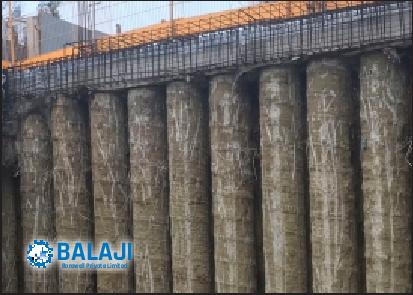Service > Service Details

Contiguous Bored Pile Wells
Contiguous pile walls are installed using rotary bored or CFA techniques. This type of retaining wall is constructed with spaces between adjacent reinforced concrete piles and is used on a range of engineering or building projects including but limited to road or rail underpasses, underground shafts/tanks, cut and cover tunnels/portals or basements. Contiguous piled walls are used in dry and cohesive soils and are often the quickest and more economic method of constructing retaining walls. In certain ground conditions it may be necessary for the design to incorporate temporary props or ground anchors to provide additional lateral support to the wall. Contiguous bored pile walls are formed by constructing piles using the CFA, LDA or CSP technique. Occasionally, a guide wall is constructed at platform level to aid positional and verticality tolerances. Piles are constructed in a sequence such that no one pile’s integrity is affected by constructing another immediately adjacent pile next. Piles are constructed so that they virtually touch each other with typical gaps of between 50mm-150mm. The soil in the gaps is exposed during excavation and can if necessary be grouted or sealed to form a watertight wall. Normally a secondary lining wall is added to provide a permanent works finish to the wall. Capability: Depending upon ground conditions, we are able to construct contiguous pile walls to a diameter of 1500mm to a depth of 32m, using CFA piling, or to the diameter of 2800mm (underarms to 7200mm) to a depth of 65m using LDA piling. Advantages: These can be used for more flexible geometry than a diaphragm wall and are suitable for ground conditions where there is no requirement to exclude ground water and vertical loads can be carried by the wall piles. Contiguous piled walls are suitable and easier to build in load variations as well as minimizing installation time, with no requirement for a guide wall. The Cased Secant Piling (CSP) system has been developed to combine the more cost-effective CFA technique with heavy duty casings that are more traditionally associated with rotary bored piling methods. The CSP method can be used to construct deep secant or contiguous piled walls depending on the actual ground conditions and water table. CSP piles are constructed by drilling hollow stem augers encased within a string of casing to the required depth. A twin rotary drive system rotating in opposite directions allows soils extraction and casing installation simultaneously. The leading casing and auger are armed with tungsten tipped cutting teeth which means the system is suitable for constructing piles in hard soils. Piles arisings are removed from the top of the auger and brought down to ground level via a chute acting as a safe system of work. The pile is then concreted using the normal CFA technique of pumping concrete through the auger stem under pressure in a controlled manner as the auger returns to ground level all of which is monitored inside the rig cabin by computer (capturing the same level of detail collected using the CFA system) in order to maintain quality. At this point the steel reinforcement cage is plunged into the concrete. Whilst the process does have limitations with respect to diameter and depth, it will generally give a better assured product in terms of vertical tolerance and visual appearance. As it is a cased system and almost vibration free it reduces the risk of distress to adjacent structures in certain soils like sands or gravels for which it is particularly suitable. Cased CSP has the methodology to be used as bearing piles, through its effectiveness of drilling through rock. Capability: Depending upon ground conditions, we can drill to 750mm, 880mm and 1000mm casings, up to 25m depth. Advantages: With CSP, there is better vertical tolerance than an uncased CFA secant wall; better ultimate appearance, and reduced overbreak compared to an uncased CFA secant wall than an uncased CFA secant wall. In addition, it is quicker than kelly/casing rotary bored pile methods and reduces the risk of ‘flighting’ in poor soils, makes it suitable for use next to sensitive structures such as tunnels.
